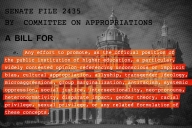You have /5 articles left.
Sign up for a free account or log in.
This past spring semester marked a heroic response to the coronavirus that prompted radical change in the mode of delivery of much of higher education -- a change that will continue to influence the way learning is accessed from this point forward. So, what did we learn?
First and foremost, we learned that we must be prepared for future pandemics, natural disasters or other breakdowns that disrupt our educational institutions and systems. Further, we learned that, in this instance, we were prepared to launch remote learning initiatives across the country to help protect our students and staff while delivering the curriculum, albeit in some cases in less than optimal presentations. We now have models upon which we must improve and expand to assure continuity of curriculum delivery in cases of disruptions.
Second, we learned that during such a disaster as this one that has claimed more than a quarter of a million lives, and caused massive disruption with mental health effects in the lives of students, faculty and staff, the mental health ramifications continue. They are not fully recognized and reported. They vary widely depending upon family/social bubbles, age and social disposition. A whole host of mental health support sites and referral services are available, but it is unclear if these fully meet the need.
Most effective faculty practices of student engagement, active learning, simulations, compassion and close attention to student well-being have been practiced by experienced online learning faculty members for many years. However, higher education faculty members are not universally grounded in these approaches and practices. Yet, the faculty are now on the front line of monitoring student behaviors that on campus had been observed by resident advisers, campus health services and other professionals who in normal conditions pay attention to student well-being.
We found that most but not all of our students had ready access to at least smartphone broadband access to learning management systems. Nevertheless, expansion of wireless and cable access to meet everyone's needs is required. Efforts in this area continue with 5G, 10G and the addition of Starlink and other satellite-based systems that are less vulnerable to the challenges that geography and rural population density present.
We know now that faculty and staff members are not immune from the impact of the pandemic. We are poised on a tidal wave of burnout. Faculty and staff have been working extra hours and extra days, nonstop, in preparing first for remote learning, then more robust online learning. As Colleen Flaherty writes in Inside Higher Ed, "Faculty Pandemic Stress Is Chronic Now":
The early days of the pandemic took a toll on faculty members, but for many, peak stress is now, according to a new study of faculty mental health from Course Hero. Researchers for the study website surveyed hundreds of faculty members on and off the tenure track, across institution types, this fall. The findings suggest that faculty worries about the pandemic have morphed into chronic stress -- with serious implications for professors’ mental health, their students and the profession as COVID-19 drags on.
So, we learned that there is a need for stress and mental health support for all in the education process: students, faculty and staff. We must be careful as we enter 2021 to assure that these needs are met.
We now have at least three different vaccines in the pipeline that promise to help protect against the current version of the COVID virus. Traditional treatments are improving with lowered death rates. New antibody treatments have been given emergency approvals for use. Yet the production, deployment and administration of these vaccines and treatments to billions of people worldwide will take a year or more. We still face a remote spring and likely summer ahead for higher education in the U.S.
Is your institution prepared to implement the practices and policies that we learned in this human disaster?
Will you implement training and support for the effective teaching practices we have learned? Will your institution address the brewing mental health issues? In the fall semester and beyond, how will our higher education model have changed? Will HyFlex, blended and online alternatives be offered for those faculty and students who may not feel safe to return to the classroom? Will your institution be prepared for the next natural/human disaster?





